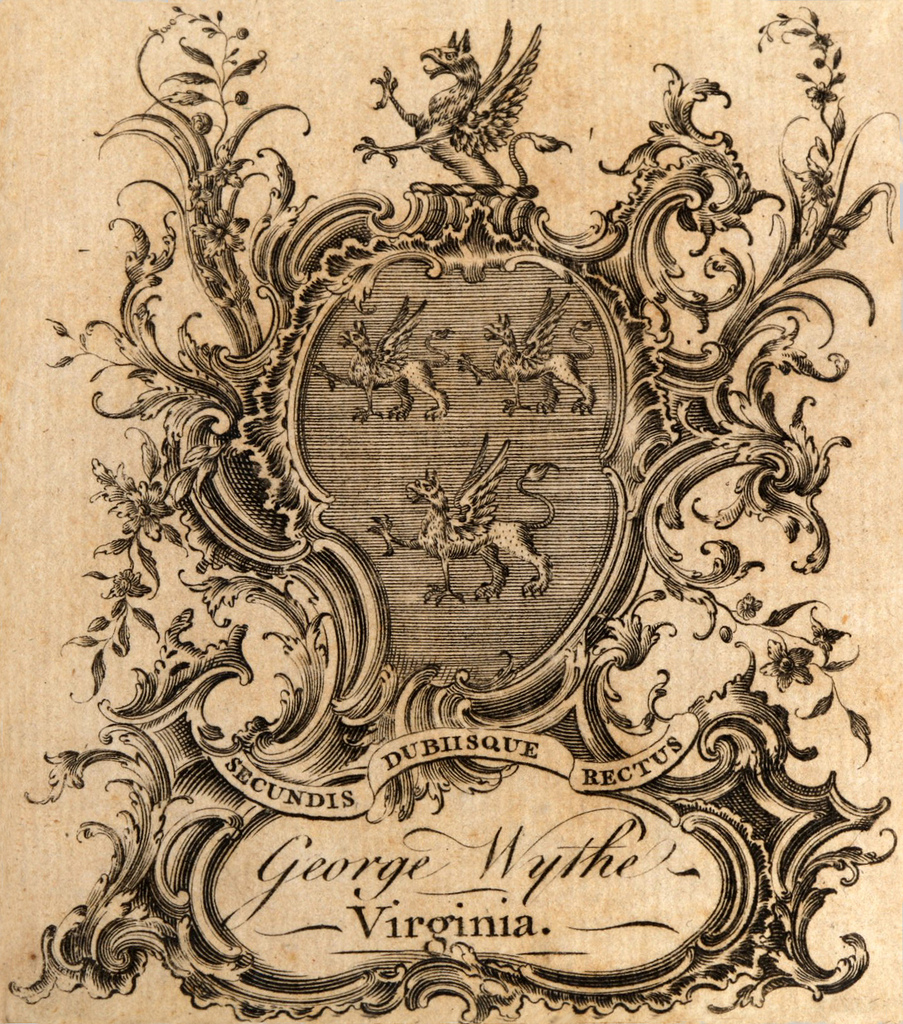Cours de Mathematiques, a l'Usage des Gardes du Corps de la Marine
by Etienne Bézout
| Cours de Mathematiques | ||
 at the College of William & Mary. |
||
| Author | Etienne Bézout | |
| Edition | Precise edition unknown. | |
| Desc. | 8vo | |
Étienne Bézout was born in 1730 in Nemours, France, to a family of magistrates.[1] In 1764, he was appointed examiner of the Gardes de la Marine, a position he would hold until his death in 1783.[2] One of his tasks was to write a textbook specifically teaching mathematics, which would later become Cours de Mathematiques, a l'Usage des Gardes du Corps de la Marine.[3] Bézout was known as a savant who was well-regarded in mathematical research circles, a contributing factor to the wide circulation of Cours.[4] He also made significant contributions to the field of elimination theory[5] through his 1779 work Théorie générale des équations algébraiques, which expanded the symmetric functions of the roots of an algebraic equation. [6] Théorie générale also established what is today known as Bézout's theorem, which states that “the degree of the eliminand of a system a n algebraic equations in n unknowns, when each of the equations is generic of its degree, is the product of the degrees of the equations.”[7]
Cours de Mathématiques was the first work for French military students that contained principles and applications of calculus, and it quickly became a best-seller both nationally and internationally.[8] Cours was published in six volumes, each focusing on a different topic: (1) elements of arithmetic; (2) elements of geometry, plane and spherical trigonometry; (3) algebra its application to arithmetic and the geometry; (4) general principles of the mechanics along with the principles of calculus; (5) application of the general principles of mechanics; and (6) a treatise on navigation.[9] When Bézout was appointed examiner of the artillery in 1768 after the death of Charles-Étienne Camus, he adapted the six volumes into four, specifically intended for artillery students.[10] The various editions of Cours would continue to be reprinted until 1822, circulating not just in French but also in English, Portuguese and Russian.[11] One English version was intended specifically for students at Harvard.[12]
Pedagogically, Cours contained mandatory information on the basic principles of mathematics, and optional content for higher-level students as well.[13] It contained the study of sine, cosine, logarithmic, and exponential quantities.[14] When teaching calculus, Bézout used the infiniment petits method, or “the infinitely small increments of variable quantities,” an approach which became dominant amongst French engineers in the 1800s.[15]
Evidence for Inclusion in Wythe's Library
Listed in the Jefferson Inventory of Wythe's Library as "Mathematiques de Bezout. 3d. & 4th. vols. 8vo." and given by Thomas Jefferson to James Ogilvie, the tutor of Jefferson's grandson Thomas Jefferson Randolph. The precise edition owned by Wythe is unknown. The Brown Bibliography[16] lists either the 1775 or 1781-1784 editions. George Wythe's Library[17] on LibraryThing indicates "Precise edition unknown. Several quarto editions were published at Paris. Jefferson's copy was of the 1781 edition." As yet, the Wolf Law Library has been unable to procure a copy of Cours de Mathematiques.
See also
References
- ↑ J. J. O'Connor and E. F. Robertson, “Étienne Bézout," MacTutor History of Mathematics, (University of St. Andrews, Scotland, February 2000).[1]
- ↑ Monica Blanco Abellán, “The Mathematical Courses of Pedro Padilla and Étienne Bézout: Teaching Calculus in Eighteenth-Century Spain and France,” Science & Education 22, no.4 (2012), 776.
- ↑ O'Connor and Robertson, "Etienne Bezout."
- ↑ Abellán, "The Mathematical Courses," 784
- ↑ Judith Grabiner, "Bezout, Etienne" in Complete Dictionary of Scientific Biography, vol. 2 (New York: Charles Scribner's Sons, 2008) 111–114.[2]
- ↑ O'Connor and Robertson, "Etienne Bezout."
- ↑ Erwan Penchèvre, “Etienne Bézout on elimination theory,” arXiv:1606.03711 (2016), 1.
- ↑ Abellán, "The Mathematical Course," 769-70.
- ↑ Abellán, "The Mathematical Course," 776-7.
- ↑ Abellán, "The Mathematical Courses," 777.
- ↑ Abellán, "The Mathematical Course," 777.
- ↑ O'Connor and Robertson, "Etienne Bezout."
- ↑ Abellán, "The Mathematical Courses," 777.
- ↑ Abellán, "The Mathematical Courses," 778.
- ↑ Abellán, "The Mathematical Courses," 779.
- ↑ Bennie Brown, "The Library of George Wythe of Williamsburg and Richmond," (unpublished manuscript, May, 2012, rev. 2014) Microsoft Word file. Earlier edition available at: https://digitalarchive.wm.edu/handle/10288/13433
- ↑ LibraryThing, s.v. "Member: George Wythe," accessed on January 28, 2015.